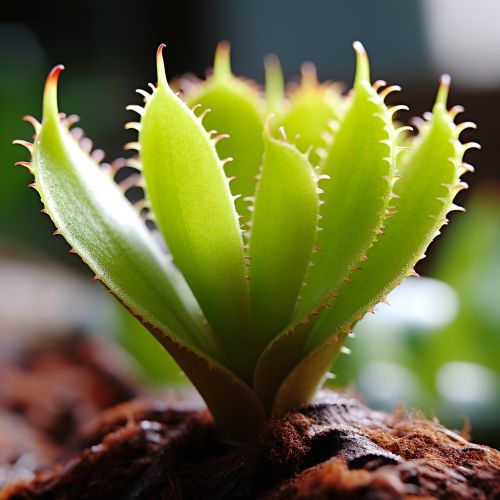Venus flytrap
Introduction
The Venus flytrap (Dionaea muscipula) is a carnivorous plant native to subtropical wetlands on the East Coast of the United States in North Carolina and South Carolina. It is one of the most recognized and widely known species of carnivorous plants due to its unique and fascinating method of capturing prey.
Description
The Venus flytrap is a small plant whose structure can be described as a rosette of four to seven leaves, which arise from a short subterranean stem that is actually a bulb-like object. Each stem reaches a maximum size of about three to ten centimeters, depending on the time of year; longer leaves with robust traps are usually formed after flowering.


Leaf-blade or lamina is divided into two regions: a flat, heart-shaped photosynthesis-capable petiole, and a pair of terminal lobes hinged at the midrib, forming the trap which is actually the true leaf. The upper surface of these lobes contains red anthocyanin pigments and its edges secrete mucilage. The lobes exhibit rapid plant movements, snapping shut when stimulated by prey.
Carnivorous Behavior
The trapping mechanism is tripped when prey items, such as insects, spiders, or even small frogs, stumble upon the plant's trigger hairs, or cilia. These sensitive hairs are located on the inner surfaces of the trap lobes, and when an unsuspecting creature disturbs these hairs, the trap is sprung.
The Venus flytrap is not a passive plant. It actively lures its prey with a sweet nectar. Once the prey is inside the trap and touches the trigger hairs, the plant responds in a fraction of a second, snapping its trap shut. The trap doesn't close all the way at first. It keeps a small opening, a strategy to let small, non-nutritious prey escape. This way, the plant ensures that it only spends energy digesting worthwhile meals.
Digestion and Nutrient Absorption
After the trap closes, the Venus flytrap begins the process of digestion. The plant produces digestive enzymes, similar to our stomach's digestive juices, that break down the soft parts of the insect. This process takes about a week. Once the nutrients from the prey are absorbed, the trap reopens, revealing the indigestible parts of the insect, such as the exoskeleton.
Reproduction
Venus flytraps reproduce both sexually and asexually. In sexual reproduction, the plant flowers in the spring, producing white blossoms that are pollinated by insects. The plant then produces seeds that are dispersed by wind or water. In asexual reproduction, the plant produces bulbs, or offshoots, that grow into new plants.
Conservation
Venus flytraps are a vulnerable species. They are threatened by habitat loss due to human development, poaching, and climate change. In the wild, they are found only in a small area of North Carolina and South Carolina. Efforts are being made to conserve this unique species, including habitat preservation and laws against poaching.
